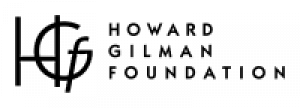Details
Contact
info@irishartscenter.org
Overview
Chapter 2
July 20-October 11, 2020
Are Irish names so hard to pronounce? Only if you don’t know how. For most of the world, Irish names are the only interaction with the Gaeilge they’ll ever have, and are therefore the language’s best opportunity to make a good first impression. In part two of our Irish Word of the Week series, which runs from July 20 through October 5, curator Darach Ó Séaghdha of @theirishfor uses popular Irish names to explain how different features of Irish spelling and pronunciation work.
The first six will be illustrated by the artist Fatti Burke, and the last six by Una Gildea.
October 5-11
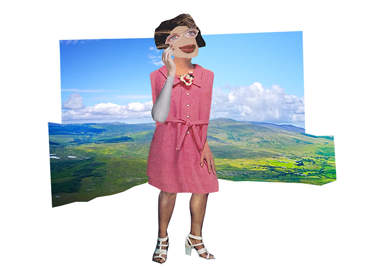
Collage by Una Gildea. For a closer view, click the photo top left of page and scroll right.
The English word “queueing” has five vowels in a row. Are they all necessary? Could the same sound be produced with fewer letters? What clues are there to tell a reader that a new syllable starts at the letter “i”? It can be very confusing.
Silent consonant combinations in Irish might appear confusing at first glance, but they do give readers clues to where syllable changes happen, and break up long runs of vowels. The triple vowel combination “aoi” sounds like “ee” in English; when it follows a consonant, there is a short “w” sound before it.
Faoi under fwee
Caoineadh crying kween-ah
Gaoithe wind gwee-hah
Aoife, meaning beauty, has been one of the top 20 Irish girl names for more than thirty years. It was the name of the princess who married Strongbow (the subject of one of Ireland’s most famous paintings) as well as stepmother to the Children of Lir.
Modern day Aoifes include singer Aoife Scott, writer and illustrator Aoife Dooley, and English footballer Aoife Mannion.
September 21-October 4
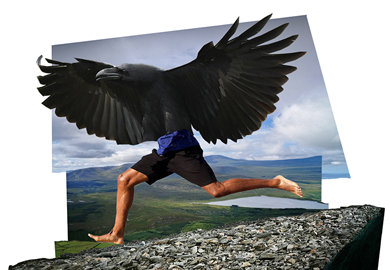
Collage by Una Gildea. For a closer view, click the photo top left of page and scroll right.
For an island roughly the size of South Carolina, Ireland has significant accent diversity: it is not unusual for locals to speak in four distinctly different accents an hour’s drive in each direction from any given point. This accent variety is present in the Irish language too, with different pronunciation norms in Ulster, Connacht, and Munster.
One of the differences between Ulster Irish and the other canúintí is that, in the middle or at the end of a word, “ch” is softened to an “h” sound. On the rest of the island, it sounds much like the “ch” in “Christmas” or “chorus.”
For example:
Luch (mouse): looh (Ulster Irish), luch(Connacht Irish)
Dúchas (heritage): doo-hass (Ulster Irish), doo-chas (Connacht Irish)
Fiachat (wild cat): fee-ah-hat (Ulster Irish), fee-chut (Connacht Irish)
Fiachra is the name of one of the children of Lir (who were turned to swans in a well-loved tale from Irish mythology) and means raven. Modern day Fiachras include journalist Fiachra Ó Cionnaith, Galway footballer Fiachra Breathnach, and musician Fiachra Trench.
September 21-27

Collage by Una Gildea. For a closer view, click the photo top left of page and scroll right.
In English, the name “Pacific Ocean” has three “c”s, each pronounced differently. There are no clues to the reader as to how—it is assumed you already know. This is a common frustration with those who study English as a second or additional language.
In Irish, every “c” is reassuringly hard, but the pronunciation of “s” depends on the vowel that comes after it. If it’s followed by a slender vowel like i/e, it sounds like “sh” (such as in Seán or Sinéad). If it’s followed by a broad vowel like a/o/u, it is a classic sibilant “ess” (like Sadbh). The name Saoirse has one of each kind of “s” and can help you remember this rule.
Examples of “s” in Irish:
Sabhaircín primrose saw-vark-een
Seanbhean old woman shan-van
Siamsa entertainment shee-am-sa
Socair calm sucker
Súil eye soole
Saoirse, meaning freedom, is an especially popular Irish name in the 21st century. Famous Saoirses include Oscar nominee Saoirse Ronan, environmentalist Saoirse McHugh, and Derry Girls star Saoirse Monica Jackson.
September 14-20

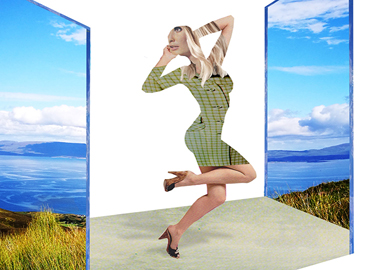
Collage by Una Gildea. For a closer view, click the photo top left of page and scroll right.
There are more than six spellings of Caoilfhionn, meaning “slim and blonde,” doing the rounds in Ireland. It’s a compound of caol (meaning narrow) and fionn (meaning fair-haired). When these two words are stuck together to make a new one, an “h” is added to the "f" for grammar reasons, which quietens it—the resulting name is pronounced keelin.
Other words with a silent "fh" include:
Aisfhreagra a back-answer ash rag a ra
Carnfholt a mass of wavy hair car nalt
Dofhaighte extremely rare doh eye tcha
Famous Caoilfhionns include actor Caoilfhionn Dunne, international human rights lawyer Caoilfhionn Gallagher, and journalist Keelin Shanley.
September 7-13

Collage by Una Gildea. For a closer view, click the photo top left of page and scroll right.
In English, the letters “gh” tend to be silent—think bough, through, doughnut. So it goes with Irish, where a “gh” in the middle or end of a word is generally not pronounced. Even though this phenomenon is common to both languages, Irish people with a “gh” in their names—the Bronaghs, Clodaghs, Fionnghualas, and Maghnuses—often report that this part of their name gets mispronounced at home and abroad.
Maghnus, meaning “great,” is a name that came to Ireland with the Vikings and is widespread—with a hard, un-lenited “g” in the middle—in Scandinavian countries. While it was a popular name with Irish royalty in the twelve and thirteenth centuries—hyacinth-eyed Maghnus Mág Samhradháin of Tullyhaw and Maghnus Ó Conchobair of Connacht—it is nowadays more commonly seen in the surname McManus (“grandson of Maghnus”).
Other examples of the silent “gh” in Irish include:
Bánaigh dawning or brightening baw-nee
Beoigh animate bee-oh
August 31-September 6

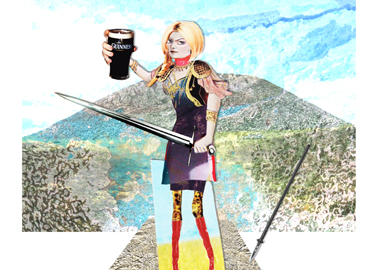
Collage by Una Gildea. For a closer view, click the photo top left of page and scroll right.
There was a sharp rise in the popularity of Irish names from the mid-sixties onwards. This was thanks partly to an increase in national self-confidence, and some of it was also down to the work of the Second Vatican Council, which led to a less strict attitude on which names were appropriate for the baptismal font. (Previously only saints’ names were deemed acceptable in many parishes.)
Coincidentally, the surge happened right after the publication of a major dictionary in 1959 in which Irish spelling was modernized, with letters like “v” and “x” included for the first time. A consequence of this modernization is that if an Irish name was popular before 1959, multiple acceptable spellings would now exist, reflecting old and new conventions. This was the case with Medhbh (or Medb, or Maeve, meaning "she who intoxicates") and Sadb (or Sadhbh, or Sive), names where the “bh” indicates a “v” sound.
Other examples of “bh” pronounced as “v” in Irish include:
Bhí was vee
Aoibhinn delightful even (or ay-veen, ee-veen)
Gábh danger gawve
Famous Medhbhs include Queen Medb, the formidable ruler of Connacht in the Táin; Maeve Binchy, one of Ireland’s best loved novelists; and poet Medbh McGuckian.
August 24-30
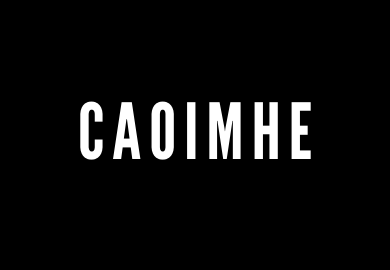
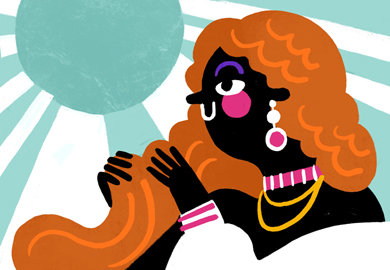
Illustration by Fatti Burke. For a closer view, click the photo top left of page and scroll right.
Like Fiadh, this is a name that became significantly more popular in the 21st century than the 20th: three Caoimhes were born in 1966; 363 arrived in 2016. “Caoimhe” has been consistently more popular than the anglicized spelling, “Keeva.” How did this happen when so many other Irish names appeared to make concessions to English spelling norms?
While Medb/Maeve, Sadhbh/Sive, Seán/Shawn and other names were popular at a time when the Irish language and pride in Irish identity was against the ropes, Caoimhe and Fiadh are names that rose in the ranks when Ireland was swaggering culturally and commercially. It was also a time when Irish language television and schools were making strides.
Caoimhe is one of the names given by parents to the first generation of daughters not expected to emigrate, who would grow up surrounded by people who would know that the “mh” sounds like a “v” in the middle or at the end of a word. Other examples of “mh” in Irish are:
Comhrá conversation coe-ra
Lámh hand law-ve
Claíomh sword kly-ive
Caoimhe means “noble” or “graceful,” but a caoimheachán is an entertainer. Famous Caoimhes include Caoimhe Buttlerly, a human rights activist, and the actor Caoimhe O’Malley.
August 17-23


Illustration by Fatti Burke. For a closer view, click the photo top left of page and scroll right.
Almost unknown as a name until a quarter of a century ago, Fiadh has become the fastest-rising girl’s name of the 2010s in Ireland, reaching third place in 2019 and showing no signs of slowing down. A large part of its popularity may stem from the poetic ambiguity in its meaning: fiadh can mean a deer, wildness in nature, or respect.
Pronounced "fee-a," the “dh” at the end of Fiadh is silent—the letter “h” next to a consonant in Irish generally advises the reader that the preceding consonant has been softened, or lenited. If the “dh” is at the start of a word or syllable, it can sound like a "y." Other examples of the silent “dh” in Irish include:
Luaidhe lead (the element) louie
Gadhrach fond of dogs gah-rach
Dúdhearg dark red do-yar-egg
There are no famous Fiadhs yet (that we know of) because its popularity has been so recent, but you can expect to hear from them soon.
August 10-16

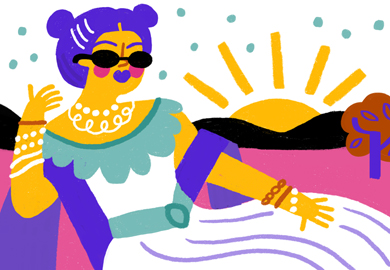
Illustration by Fatti Burke. For a closer view, click the photo top left of page and scroll right.
The perception that some Irish names are hard to pronounce is compounded by many having multiple accepted spellings (although bearers of those names are fiercely loyal to their own). Órla is an abbreviation of Órfhlaith, a compound of the word for gold (ór) and nobility (flaith). As this name was already popular prior to both widespread literacy and the spelling modernizations introduced in the 1950s, there was plenty of time for different spellings to take root in different communities.
Teachers warning their students of the importance of a fada will often point out that without the accent, Orla (‘uhr-lah’) would mean “vomit” rather than “golden princess.” However, Órlas have to live with this indignity in an online world where many websites won’t accept non-standard characters.
Pronunciation: with a fada, “Ó” sounds like ‘oh’ in English—just as the “Ó” at the start of many Irish surnames sounds. Other examples include:
Bó cow boh
Rón seal roh-n
Fiaclóir dentist fee-ack-lore
Famous Órlas/Orlas/Órfhlaiths include journalist Orla Guerin, designer Orla Kiely, Northern Irish MP Órfhlaith Begley, and actor Orla Brady.
August 3-9
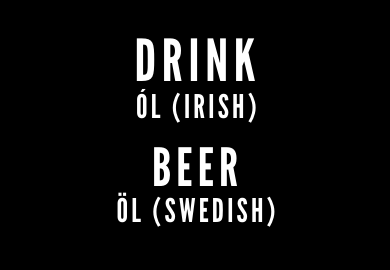
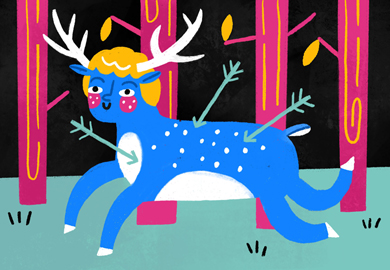
Illustration by Fatti Burke. For a closer view, click the photo top left of page and scroll right.
One of the fastest-growing boy names of the 21st century in Ireland, Oisín is well-known to Irish schoolchildren of all ages due to its place in a famous legend. In the story of Tír na nÓg, Oisín, a human, meets Niamh, a beautiful princess from the land of eternal youth. She invites him to join her there, but if he does—he can never come back.
The literal meaning of the name is fawn, which is especially interesting because in a less well-known legend, Oisín’s mother is turned into a deer for a period of time.
Oisín is pronounced ush-een. The “i” carries a fada, just like Tír in Tír na nÓg, which makes the letter sound like “ee.” Generally, the -ín suffix is more common in girl names, such as:
Róisín Little rose Roe-sheen
Réiltín Little star Ray-ill-teen
Bláithín Little flower Blah-heen
July 27-August 2
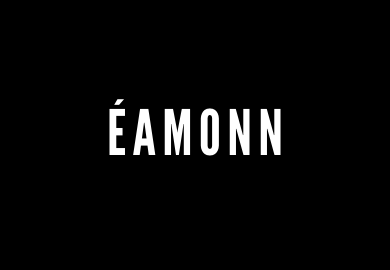
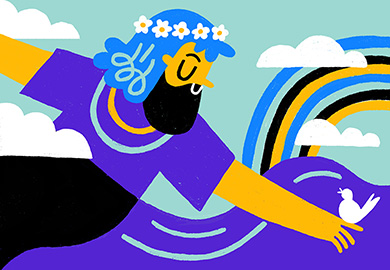
Illustration by Fatti Burke. For a closer view, click the photo top left of page and scroll right.
Éamonn, or Éamon, is often translated as “rich protector,” although modern Irish doesn't use it as a word to mean that. The rise and fall of this name’s popularity hews closely to the popularity of Éamon De Valera, the leader who dominated 20th century Irish politics.
Some confusion with Irish name pronunciation occurs when one grows so common that people begin to drop the fadas that might otherwise direct the pronouncer. This is true of Éamonn and of Sinéad (De Valera’s wife’s name, incidentally), whose “e” have accents, advising that they should sound like “ay” in English.
From the artist:
"Éamonn means 'rich protector', and although I'm not a religious person, the name made me think of an almighty protector of our land, sea and air. With a nod to Michaelangelo's The Creation of Adam, I like the idea of a flower-crowned king protecting our most vulnerable and most valuable asset; nature itself! It's also a bonus that Éamonn sounds a lot like Amen." — Fatti Burke
July 20-26
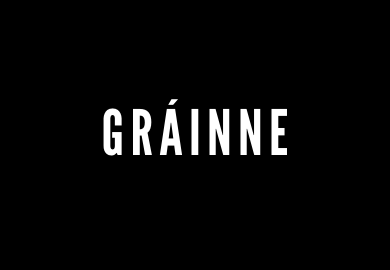
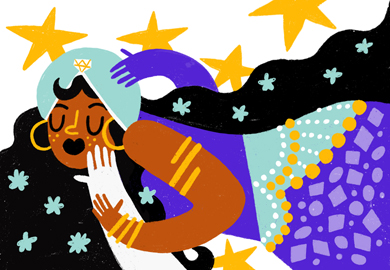
Illustration by Fatti Burke. For a closer view, click the photo top left of page and scroll right.
Gráinne is sometimes anglicized as Grace, although the names have little in common other than beginning with the same two letters. “Gráinne” means precious or beloved thing, related to the Irish for love, grá. Older dictionaries also define it as a seed—something small with great potential. The Irish for a hedgehog is gráinneog, although it’s unclear whether the creature or the person’s name came first.
Pronounced graw-in-yah. The fada on the “a” lengthens the vowel. Other words with an "á" include:
Tá it is taw
Máthair mother maw-her
Arán bread Ah-rawn
Famous Gráinnes from history include the princess in mythology who was engaged to Fionn McCool but ran away with his one of his warriors, and Ireland’s pirate queen, Gráinne Mhaol ("Bald Gráinne”), who ruled the Irish coastline in the 16th century. In current day, the name is often associated with the popular broadcaster and businesswoman Gráinne Seoige.
From the artist
"Gráinne, meaning precious thing, makes me think of a woman who's adored and valuable in her aesthetic and contributions. I gave a nod to Gustav Klimt's The Kiss in this illustration, as it's an artwork that evokes both opulence and overwhelming love in my mind. Gráinne, as a precious person, is seen being embraced and draped in sparkles—covered in grá." — Fatti Burke



